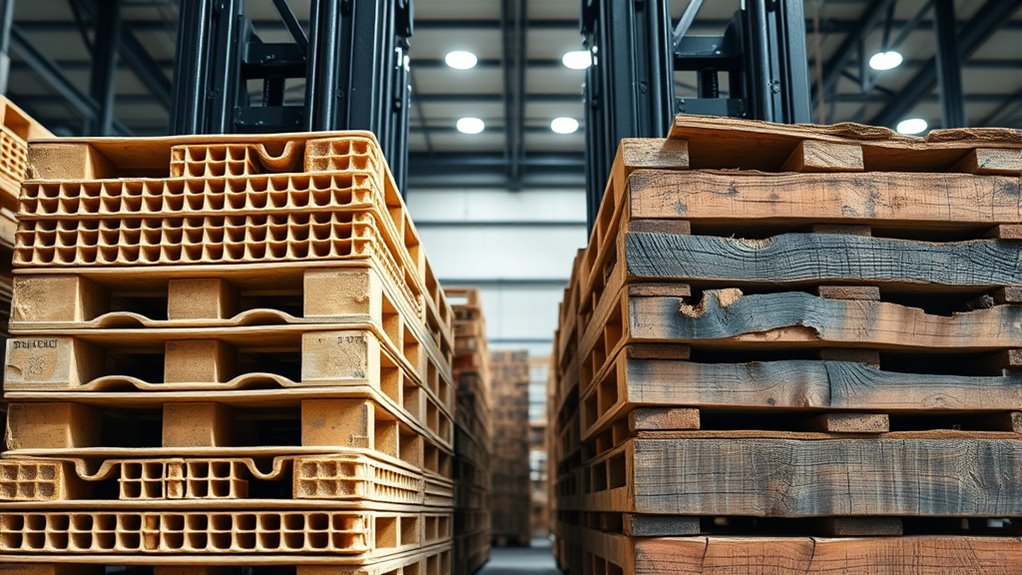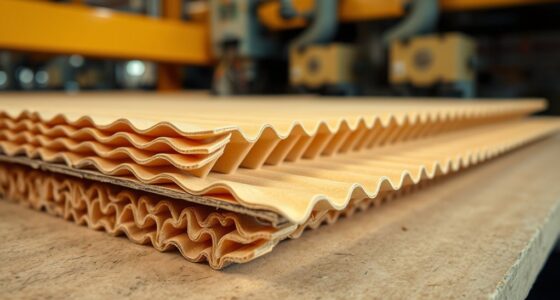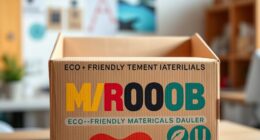When comparing corrugated and wooden pallets, consider your specific needs. Corrugated pallets are lightweight, eco-friendly, and cost-effective for short-term or light loads, but may lack durability for heavy or rough handling. Wooden pallets are sturdier, reusable, and better suited for demanding, long-term use, though they come with higher upfront costs. To find the best fit for your operations, explore further insights that highlight their differences and advantages.
Key Takeaways
- Corrugated pallets are lightweight, eco-friendly, and suitable for light to moderate loads, while wooden pallets are more durable and handle heavier weights.
- Wooden pallets generally have higher upfront costs but are more reusable and repairable for long-term heavy-duty use.
- Corrugated pallets are made from recycled materials, making them more sustainable and easier to recycle after disposal.
- Wooden pallets are better for demanding shipping environments due to their strength and durability over prolonged use.
- The choice depends on operational needs, load requirements, sustainability goals, and budget considerations.

When choosing between corrugated and wooden pallets, understanding their differences can help you make a better decision for your logistics needs. Both options serve the purpose of transporting and storing goods, but they vary considerably in terms of eco friendly options and cost comparison. Your choice impacts not only your budget but also your company’s sustainability efforts.
Corrugated pallets are lightweight, made from sturdy cardboard, and are generally regarded as more eco friendly options. They are often recyclable and can be reused multiple times if maintained properly. Since they are made from recycled materials, they contribute less to deforestation and reduce environmental impact. If your business prioritizes sustainability, corrugated pallets are an attractive choice. They also generate less waste when discarded, as many are recyclable through local programs. However, it’s essential to take into account their durability, as they may not withstand heavy loads or rough handling over time. For light to moderate shipping needs, they fit well and support eco-conscious initiatives.
On the other hand, wooden pallets are traditional and renowned for their strength and durability. They can handle heavier loads and endure rough handling, making them suitable for demanding logistics operations. Yet, when it comes to eco friendly options, wooden pallets present a mixed picture. While they are often reusable and repairable, their production involves harvesting timber, which can contribute to deforestation if not managed responsibly. Nonetheless, many wooden pallets are recycled or refurbished, extending their lifespan. The cost comparison generally favors wooden pallets in the long run because they can be reused multiple times, especially if maintained properly. They tend to be more cost-effective for heavy-duty applications, but the initial purchase price and maintenance costs can be higher than corrugated options.
In terms of cost comparison, corrugated pallets often cost less upfront, especially for single-use or short-term needs. They’re cheaper to produce, transport, and dispose of, which can lower your overall logistics expenses. However, if your operation involves frequent handling of heavy loads or long-term usage, wooden pallets might prove more economical over time due to their durability and reusability. When weighing these factors, take into account your specific shipping volume, load weight, and sustainability goals. Corrugated pallets may suit lighter, eco-conscious shipments, while wooden pallets excel in heavy-duty, long-term applications.
Ultimately, your decision hinges on balancing eco friendly options with your budget and operational demands. If minimizing environmental impact is a top priority, corrugated pallets offer a compelling choice. For heavy, repetitive loads, wooden pallets might serve you better, especially when factoring in their reusability and cost efficiency over time. Additionally, advancements in sustainable manufacturing practices are improving the environmental profile of wood products, making them a more viable choice for eco-conscious companies seeking durability.
Frequently Asked Questions
Are Corrugated Pallets Suitable for Heavy-Duty Industrial Use?
Yes, corrugated pallets can be suitable for heavy-duty applications, but you need to take their load capacity carefully into account. They’re generally designed for lighter loads and quick turnover, but some high-strength options can handle heavier weights. Always check the load capacity considerations and make sure the pallet’s specifications match your heavy-duty needs. For extremely demanding applications, wooden pallets might still be the more reliable choice, but modern corrugated options are increasingly capable.
How Do Moisture Levels Affect the Durability of Wooden Pallets?
Moisture levels substantially impact the durability of wooden pallets. When exposed to excess moisture, you risk moisture damage, which weakens the wood structure and accelerates decay. Additionally, high humidity promotes mold growth, further compromising the pallet’s integrity and safety. To prevent these issues, you should store wooden pallets in dry environments and guarantee proper ventilation, which helps maintain ideal moisture levels and extends their lifespan.
Can Corrugated Pallets Be Recycled or Reused?
Yes, corrugated pallets can be recycled or reused. You can recycle them through various options like crushing for fiber reuse or repurposing them into new packaging materials, reducing waste. Their reuse potential is high; you might reinforce or refurbish them for multiple shipments, saving costs and supporting sustainability. With proper handling, you turn these lightweight pallets into valuable resources, making them an eco-friendly choice for your logistics needs.
What Are the Safety Considerations for Handling Wooden Pallets?
When handling wooden pallets, you need to consider safety carefully. Watch out for pallet fire hazards, especially if pallets are stored near heat sources or exposed to sparks. Also, handle them ergonomically to avoid strains or injuries, since heavy or poorly balanced pallets can cause musculoskeletal problems. Always wear gloves and proper footwear, and ensure proper lifting techniques to minimize risks and maintain a safe working environment.
Do Corrugated Pallets Meet International Shipping Standards?
You’ll find corrugated pallets meet international shipping standards, making them a smart choice. Notably, their environmental impact is lower because they’re recyclable and lightweight, reducing carbon footprints. Plus, their cost efficiency appeals to many businesses, as they’re often cheaper than wooden options and easier to handle. So, when considering global logistics, corrugated pallets provide a compliant, eco-friendly, and budget-friendly solution that aligns well with international shipping requirements.
Conclusion
When choosing between corrugated and wooden pallets, consider your specific needs and priorities. Corrugated pallets offer lightweight, cost-effective, and eco-friendly options, perfect for lighter loads and quick turnover. Wooden pallets, on the other hand, provide durability and strength for heavier shipments. Remember, “You get what you pay for,” so weigh the benefits against your requirements. Ultimately, selecting the right pallet depends on balancing cost, durability, and environmental impact to keep your supply chain running smoothly.










